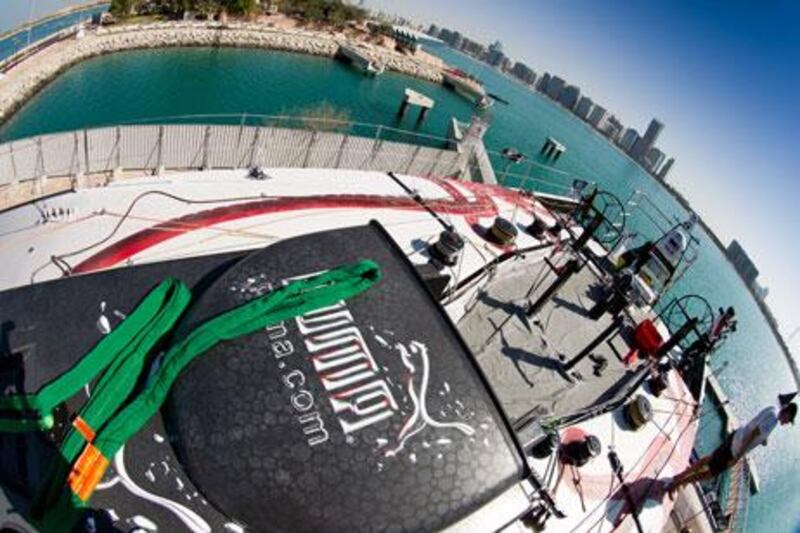When a boat has sailed 10,000 nautical miles and the skipper claims it has yet to find its ideal weather, he might seem stuck at the intersection of denial and balderdash.
Instead, the comment is not only plausible but alludes to some hard decisions from way back.
Back in their campaigns' embryonic days, the Volvo Ocean Race teams faced moments almost cruelly pivotal as they consulted yacht designers.
Even as studies have shown that decisions tax human brains, they had to choose sets of strengths and weaknesses for their boats-to-be as applied to a round-the-world, nine-month, 39,270-nautical mile race still more than a year in the future.
"It's pretty typical for someone to come to you and ask for an all-around boat," said Patrick Shaughnessy of Farr Yacht Design, which devised Abu Dhabi Ocean Racing's Azzam. "There's really no such thing as that. It doesn't exist."
A team or an individual might approach Farr hankering for a boat.
The Farr savants, in turn, will ask which events the team or individual intends to sail. Next, they might check the typical conditions for the region of the regatta. Then, those conditions lend bias to the design.
"Then," Shaughnessy said, "you layer on some psychology. You want them to start strong."
When the region of the race includes four oceans and six continents and in-port races and three-week ocean legs, the art of choosing whether a boat will excel in lights winds, or reaching, or downwind, or upwind, well, it could addle a normal brain.
Or, as Ian Walker, the Abu Dhabi skipper, said, "I could have said to Farr, 'We need a fast-reaching boat'. That might have made us super-slow in light winds."
"You really start off by what the course is," said fellow skipper Chris Nicholson, whose Camper With Emirates Team New Zealand entry still has not found its weather even after a strong second place opening.
"Then you do a very in-depth weather study on the entire course. Then you have a set of numbers for what you think the design of the boat will be."
For a leg such as the upcoming Abu Dhabi to China voyage, for example, they will study the last 20 years of weather for the three calendar weeks on either side of the starting date.
They will canvass "the crew's thoughts and debriefs from the previous race," Nicholson said, which can lead to another human difficulty: confessing past error.
In helping order up the Camper boat from the designer, Marcelino Botin, and the Emirates Team New Zealand Design Team, Nicholson drew on his experience from his watch captain stint on the 2008/09 Puma boat.
Camper sought a "stability boat", Nicholson said, "because we'd nose-dive a bit" with Puma.
"In certain sea states, we wouldn't be able to push the boat as hard as the other guy. You've got to be able to admit when you've done things the wrong way. Some people refuse to acknowledge any wrongdoing."
Some people have spent a lot of money to be hopeless.
"I've seen in the past, teams just design the wrong boat," Nicholson said. "That's it. Race done." He could tell straightaway, for he has seen the peculiar horror of hull bulbs too small, or hulls too heavy.
Then, of course, after all the design and the thinking and the choosing, the weather might just do as it pleases anyway.
"I think everyone would agree that the weather in Leg 1 and Leg 2 hasn't been what we expected," Nicholson said.
Walker said: "We spend tens of thousands of pounds on researching the weather before we design our boats, but no one would have said there would be no trade winds in Leg 1, and in Leg 2 you'd normally head south and get the strong westerlies," but they wound up "banging our heads against this trough in the Indian Ocean for a week. It was slightly unusual."
Enlightened forecasters, after all, saw Azzam's design as hinting at spryness downwind (also known as "running"). "Normally, we would have done a lot of running by now," Walker said. "We would have done two-and-a-half weeks of running." And now: "We haven't done any yet."
After all, before the Leg 2 weather puzzle, Abu Dhabi broke its mast on the first night of Leg 1.
An educated school of thought had it that Azzam could thrive particularly from Spain to South Africa, down-planet, as if a broken mast needs any extra dose of lament.
That same school likes Camper in an upwind-prone Leg 3, and Nicholson said, "We're pretty good, I think, upwind," with the emphasis in this grand guessing game always on "I think."





